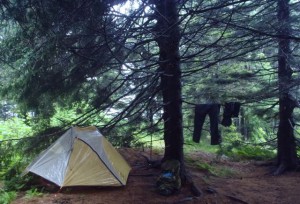
There are some things you do that you just don’t think about — you just do. Hiking is one of those things for me. Hitting the trail is just a part of life, as natural, nearly, as eating and drinking, sleeping and breathing. But every once in a while it’s not a bad think to look at why we do the things we do. For the three days, I will, quickly (in about 500 words) look at what it is that makes me hike.
Tuesday: The Outdoors
Wednesday: The People
Today: The Challenge
This is a shot from my last excursion into the woods. It was a great trip, which may surprise you if you look closely at this picture.
At first blush, it appears to be a tent pitched beneath a black balsam. Look closely at the base of the “tent,” and you’ll realize it’s just a shell of a tent — the rainfly.
Two weeks back I worked in a quick, two-night trip to the Shining Rock Wilderness in the Pisgah National Forest of western North Carolina. The trip was actually a trip delayed — and packed for — a month earlier. That trip got scuttled, but since I knew I’d be going back up soon, I didn’t see the need to unpack. My sleeping bag can survive being scrunched up for a couple weeks, I reasoned. And my food is mostly freeze-dried or otherwise soundly sealed; it can last a month or so in the cool basement.
But a sinking feeling came over me when I arrived at the trailhead at 10:30 my first night. As I pulled my pack out of the trunk, to the accompaniment of an incoming electrical storm, I noticed my tent poles weren’t strapped to the bottom of my pack, as per my usual custom. Maybe I packed them inside with the tent, I thought, a thought that seemed highly dubious. The impending storm and this new development casting doubt on my shelter for the evening prompted me to seek a site in a black balsam stand just a quarter mile in.
Sure enough, when I hurriedly started unpacking my poles were not to be found. Drops of rain were starting to ping in the canopy, claps of thunder drew closer. I flashed my headlamp around and discovered the balsam I’d decamped at was one of the few with branches near the ground. I fetched my rainfly and turned it inside out so that the velcro straps intended to secure the fly to the tent poles could clamp onto a sturdy branch four feet off the ground. I took the five available tent stakes and secured the fly’s ends into the soft bed of pine needles. Two ends remained; I used draw cord to tie those off to my hiking poles, which I’d driven into the turf. I threw my gear into my temporary shelter, crawled in after, and hoped for the best. The rain began in earnest about 20 minutes later and lasted most of the night.
There was a time, early on in my hiking and backpacking career, that the mere suggestion of missing poles would have driven me to the nearest Motel 6. And there was a time not long before that that the notion of heading out on the trail at 10:30 at night would have seemed daft. But exploring the outdoors is not about basic cable at night and letting the sun dictate your day. And while it’s not about disrespecting the power of nature, it’s also not about limiting your experiences to 72-degree days, cloudless skies and 10 percent humidity.
I worked through a little adversity, crawled into my sleeping bag and drifted off to the sound of distant thunder and rain working its way through the canopy onto my rainfly shelter.
I didn’t wake up until morning — bone dry.
* * *
Like us on Facebook and get health, fitness and outdoors news throughout the day.
